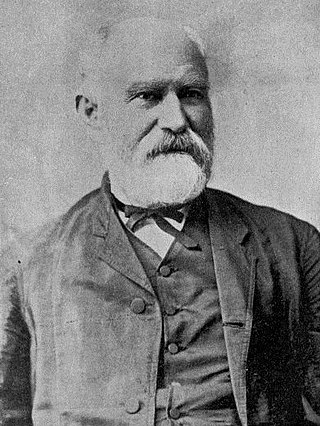Related Research Articles

Thomas Spencer Forsaith, JP, was a New Zealand politician and an Auckland draper. According to some historians, he was the country's second premier, although a more conventional view states that neither he nor his predecessor should properly be given that title.
Charles John Taylor was a New Zealand politician.
The 2nd New Zealand Parliament was a term of the Parliament of New Zealand. It opened on 15 April 1856, following New Zealand's 1855 election. It was dissolved on 5 November 1860 in preparation for 1860–61 election. The 2nd Parliament was the first under which New Zealand had responsible government, meaning that unlike previously, the Cabinet was chosen by Parliament rather than by the Governor-General of New Zealand.

Thomas Maxwell Henderson was a New Zealand politician. He was one of the earliest settlers in Auckland. He was a significant entrepreneur, and is the namesake of the Auckland suburb Henderson.

Thomas Bannatyne Gillies was a 19th-century New Zealand lawyer, judge and politician.

William Brown was a 19th-century Scottish-born New Zealand politician, merchant and newspaper proprietor.

Theodore Minet Haultain was a 19th-century New Zealand politician and Minister of Colonial Defence (1865–69). He came to New Zealand as a soldier and farmed in south Auckland.
Mongonui was a parliamentary electorate in the Far North District in the Northland region of New Zealand, from 1861 to 1870. It was represented by three Members of Parliament.
The Southern Division was a New Zealand parliamentary electorate in the Auckland Province from 1853 to 1860. It was a large two-member electorate south of the town of Auckland.
Pensioner Settlements was a 19th-century parliamentary multi-member electorate in the Auckland region of New Zealand, from 1853 to 1870.
Northern Division was a two-member parliamentary electorate in the Auckland Region, New Zealand from 1853 to 1870.
Suburbs of Auckland was a parliamentary electorate in Auckland, New Zealand, from 1853 to 1860.
The 3rd New Zealand Parliament was a term of the Parliament of New Zealand. Elections for this term were held between 12 December 1860 and 28 March 1861 in 43 electorates to elect 53 MPs. Two electorates were added to this during this term, Gold Fields District and a new Dunedin electorate created by splitting the existing City of Dunedin into Dunedin and Suburbs North and Dunedin and Suburbs South, increasing the number of MPs to 57. During the term of this Parliament, six Ministries were in power.
The 4th New Zealand Parliament was a term of the Parliament of New Zealand.

Major Francis Eastwood Campbell was the second Clerk of the New Zealand House of Representatives, serving for 35 years from 1854. An unusual aspect of Campbell's tenure as Clerk of the House was that for the last 21 years that he held this office he also served as the Clerk of Parliaments, an office traditionally reserved for the clerk of the upper house in a Westminster parliamentary system.
The January 1860 Suburbs of Auckland by-election was a New Zealand by-election held in the Suburbs of Auckland electorate following the resignation of Walter Brodie. He was replaced by Theophilus Heale unopposed.
The April 1860 Suburbs of Auckland by-election was a New Zealand by-election held in the Suburbs of Auckland electorate following the resignation of Frederick Merriman. He was replaced by Joseph Hargreaves unopposed.
The August 1860 Suburbs of Auckland by-election was a New Zealand by-election held in the Suburbs of Auckland electorate following the resignation of Joseph Hargreaves. He was replaced by John Logan Campbell unopposed.
The 1867 Northern Division by-election was a by-election to the New Zealand House of Representatives, during the term of the 4th Parliament on 1 July. The Northern Division electorate was a mostly rural electorate in the northern Auckland region.
References
- ↑ "The General Assembly". Daily Southern Cross . 22 May 1860.
- ↑ "Untitled". New Zealander. 23 May 1860.
- ↑ "Election for the Northern Division". Daily Southern Cross. 25 May 1860.